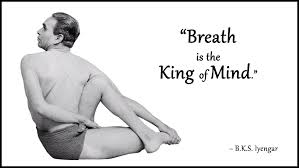WHAT IS IYENGAR YOGA?
Iyengar Yoga was named after and developed by B.K.S. Iyengar who was a direct disciple of T. Krishnamacharya. They, together with Patabbhi Jois (who developed Ashtanga Yoga) and a few others, were responsible of bringing the practice of modern yoga (as we know it now) to the West.
“Iyengar Yoga comes directly from the most classical Hatha yoga tradition, but it has evolved into a very precise and clear method that is easily understood by the modern practitioner. There is a lot of attention paid to the technical alignment of the poses to keep the mind drawn inwards, but also focused and connected to reality.” - Adela Serrano
What makes it unique?Iyengar Yoga focuses on three aspects: alignment, sequencing and timing.
“Iyengar Yoga comes directly from the most classical Hatha yoga tradition, but it has evolved into a very precise and clear method that is easily understood by the modern practitioner. There is a lot of attention paid to the technical alignment of the poses to keep the mind drawn inwards, but also focused and connected to reality.” - Adela Serrano
What makes it unique?Iyengar Yoga focuses on three aspects: alignment, sequencing and timing.
- Alignment means maintaining the intended pose while respecting the body’s boundaries. The use of props are encouraged to assist students into an asana without putting them at risk of injury. Effective alignment can then help to achieve balance between body, mind and breath.
- Sequence refers to the order that the postures are practised in to enable a safe and structured progression of the poses, along with the ‘opening’ and balance of the physical and emotional body.
- Timing: unlike Vinyasa Yoga poses are held for longer periods of time. When stability has been achieved in a pose, it’s then possible to safely intensify the depth of the posture. This helps to help develop strength and flexibility, along with sensitivity and awareness between the body and mind.
Teaching Iyengar Yoga - Iyengar Yoga teachers undergo a strict and in-depth training of three years before they get their first certificate. Afterwards, their training is ongoing according to standards set by the various Iyengar Associations in the world and supervised personally by the Iyengars in Pune.
What are the benefits? - Mr. Iyengar started practicing yoga because he had poor health as a child but with daily practice his health and strength improved and he experienced great benefits in his own body. This enabled him to develop an extensive knowledge of anatomy and a therapeutic approach to the practice.
As he recognised that all bodies are unique and have different strengths and weaknesses, Mr Iyengar also advocated the use of props - blocks, chairs, belts and blankets, etc. - to help students to gain the correct alignment suitable for their individual body. This also ensured that asanas could be practised safely and harmoniously. - Photographs of Mr Iyengar, who died at the age of 95, may be proof themselves that the benefits are plentiful!
- A regular Iyengar practice will help to:
- improve physical and psychological health
- alleviate postural/structural problems
- release emotional tension
- Who is Iyengar suitable for?
- In a word - everybody! It is a both suitable for beginners and intermediate/advanced students.
- increase focus and concentration
- increase your energy and strength
- reconnect with your body and breath
- bring intelligence and clarity to all parts of the body and mind.

